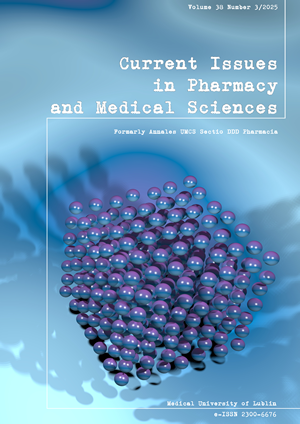Monitoring of patients with concomitant diseases post coronavirus infection
DOI:
https://doi.org/10.12923/cipms-2025-0021Słowa kluczowe:
post-COVID-19 symptoms, concomitant diseases, side effects, adverse drug reactionsAbstrakt
This survey study presents data on the prevalence of, and the risk factors associated with post-COVID-19 complications for surviving patients with concomitant diseases during and after months of infection by coronavirus.
A prospective, questionnaire-based study was conducted from May 2021 to June 2022. Patients who recovered from COVID-19 in 62 countries completed the online survey or did so during visits to hospitals and health centers. Individuals who recovered from COVID-19 were asked about their symptoms, adverse effects and adverse drug reactions. They were also asked if their concomitant diseases (diabetes, cardiovascular illness, asthma and GIT diseases) were affected after infection and if they had an uncontrolled treatment regimen. The severity of COVID was studied and the correlation coefficient to uncontrolled concomitant diseases was analyzed.
Overall, 844 patients (44% female, 56% male) were assessed, and the highest percentage were suffering from long-term cough, dyspnea, constipation and uncontrolled concomitant diseases. A high significantly positive correlation between the severity of COVID infection and uncontrolled concomitant diseases was recorded.
Many patients with mild to severe disease presentation reported persistent symptoms months later. Long-term complications to the lungs, heart, vascular system, kidneys, as well as metabolic disruption appear as uncontrolled treatment regimens for surviving COVID-19 patients.
Bibliografia
1. Larun L, Brurberg KG, Odgaard-Jensen J, Price JR. Exercise therapy for chronic fatigue syndrome. Cochrane Database Syst Rev. 2017;4: CD003200.
2. Dasgupta A, Kalhan A, Kalra S. Long term complications and rehabilitation of COVID-19 patients. J Pak Med Assoc. 2020;70: S131-5.
3. Fan Y, Zhao K, Shi Z-L, Zhou P. Bat coronaviruses in China. Viruses. 2019;11(3):210.
4. Lu R, Zhao X, Li J, Niu P, Yang B, Wu H, et al. Genomic characteri-sation and epidemiology of 2019 novel coronavirus: implications for virus origins and receptor binding. Lancet. 2020;395(10224):565-74.
5. Pan X, Chen D, Xia Y, Wu X, Li T, Ou X, et al. Asymptomatic cases in a family cluster with SARS-CoV-2 infection. Lancet Infect Dis. 2020;20(4):410-1.
6. Kupferschmidt K, Cohen J. Race to find COVID-19 treatments accelerates. Am Assoc Advance Sci. 2020;367(6485):1412-3.
7. Mollica V, Rizzo A, Massari F. The pivotal role of TMPRSS2 in coronavirus disease 2019 and prostate cancer. Future Oncol. 2020; 16(27):2029-33.
8. Hoffmann M, Kleine-Weber H, Schroeder S, Krüger N, Herrler T, Erichsen S, et al. SARS-CoV-2 cell entry depends on ACE2 and TMPRSS2 and is blocked by a clinically proven protease inhibitor. Cell. 2020;181(2):271-80.
9. Cascella M, Rajnik M, Cuomo A, Dulebohn SC, Di Napoli R. Features, evaluation, and treatment coronavirus (COVID-19). StatPearls. StatPearls Publishing; 2020.
10. Clerkin KJ, Fried JA, Raikhelkar J, Sayer G, Griffin JM, Masoumi A, et al. Covid-19 and cardiovascular disease. Circulation. 2020;141: 1648-55.
11. Guo Y-R, Cao Q-D, Hong Z-S, Tan Y-Y, Chen S-D, Jin H-J, et al. The origin, transmission and clinical therapies on coronavirus disease 2019 (COVID-19) outbreak – an update on the status. Military Med Res. 2020;7:1-10.
12. Richardson S, Hirsch JS, Narasimhan M, Crawford JM, McGinn T, Davidson KW, et al. Presenting characteristics, comorbidities,
and outcomes among 5700 patients hospitalized with COVID-19 in the New York City Area. JAMA. 2020;323:2052-9.
13. Yang J, Zheng Y, Gou X, Pu K, Chen Z, Guo Q, et al. Prevalence of comorbidities in the novel Wuhan coronavirus (COVID-19) infection: a systematic review and meta-analysis. Int J Infect Dis. 2020;94:91-5.
14. Zaim S, Chong JH, Sankaranarayanan V, Harky A. COVID-19 and multiorgan response. Curr Probl Cardiol. 2020;2020:100618.
15. Achkar M, Jamal O, Chaaban T. Post-COVID lung disease(s). Ann Thorac Med. 2022;17:137-44.
16. He H, Hu C, Xiong N, Liu C, Huang X. How to transform a general hospital into an “infectious disease hospital” during the epidemic of COVID-19. Critical Care. 2020;24:2-7.
17. Fernandes PMP, Mariani AW. Life post-COVID-19: symptoms and chronic complications. Sao Paulo Med J. 2021;139(1):1-2.
18. Zhao Z, Zhao Y, Wang Y, Zhou Y, Zuo M, Zuo W. Single-cell RNA expression profiling of ACE2, the receptor of SARS-CoV-2. Am J Respir Crit Care Med. 2020;202(5):756-9.
19. Zhang H, Penninger JM, Li Y, Zhong N, Slutsky AS. Angiotensin-converting enzyme 2 (ACE2) as a SARS-CoV-2 receptor: molecular mechanisms and potential therapeutic target. Intensive Care Med. 2020;46(4):586-90.
20. Ghoneim S, Butt MU, Hamid O, Shah A, Asaad I. The incidence of COVID-19 in patients with metabolic syndrome and non- alcoholic steatohepatitis: A population based study. Metab Open. 2020;8:10005.
21. Gold MS, Sehayek D, Gabrielli S, Zhang X, McCusker C, Ben-Shoshan M. COVID-19 and comorbidities: a systematic review and meta-analysis. Postgrad Med. 2020;132:8:749-55.
22. Shah W, Hillman T, Playford ED, Hishmeh L. Managing the long term effects of covid-19: summary of NICE, SIGN, and RCGP rapid guideline. BMJ. 2021;372:136-9.
23. Harmer D, Gilbert M, Borman R, Clark KL. Quantitative mRNA expression profiling of ACE 2, a novel homologue of angiotensin converting enzyme. FEBS Lett. 2002;532:107-10.
24. Wang D, Hu B, Hu C, Zhu F, Liu X, Zhang J, et al. Clinical characteristics of 138 hospitalized patients with 2019 novel coronavirus-infected pneumonia in Wuhan, China. JAMA. 2020; 323:1061-9.
25. Cao J, Tu WJ, Cheng W, Yu L, Liu YK, Hu X, et al. Clinical features and short-term outcomes of 102 patients with coronavirus disease 2019 in Wuhan, China. Clin Infect Dis. 2020;71:748-55.
26. Arentz M, Yim E, Klaff L, Lokhandwala S, Riedo FX, Chong M, et al. Characteristics and outcomes of 21 critically ill patients with COVID-19 in Washington State. JAMA. 2020;323:1612-4.
27. Chen T, Wu D, Chen H, Yan W, Yang D, Chen G, et al. Clinical characteristics of 113 deceased patients with coronavirus disease 2019: retrospective study. BMJ. 2020;368:1091.
28. Iqbal A, Iqbal K, Arshad Ali S, Azim D, Farid E, Baig MD, et al. The COVID-19 sequelae: a cross-sectional evaluation of post-recovery symptoms and the need for rehabilitation of COVID-19 survivors. Cureus. 2021;13(2):e13080.
Pobrania
Opublikowane
Numer
Dział
Licencja
Prawa autorskie (c) 2025 Autorzy

Praca jest udostępniana na licencji Creative Commons Attribution-NonCommercial-NoDerivatives 3.0 Unported License.


